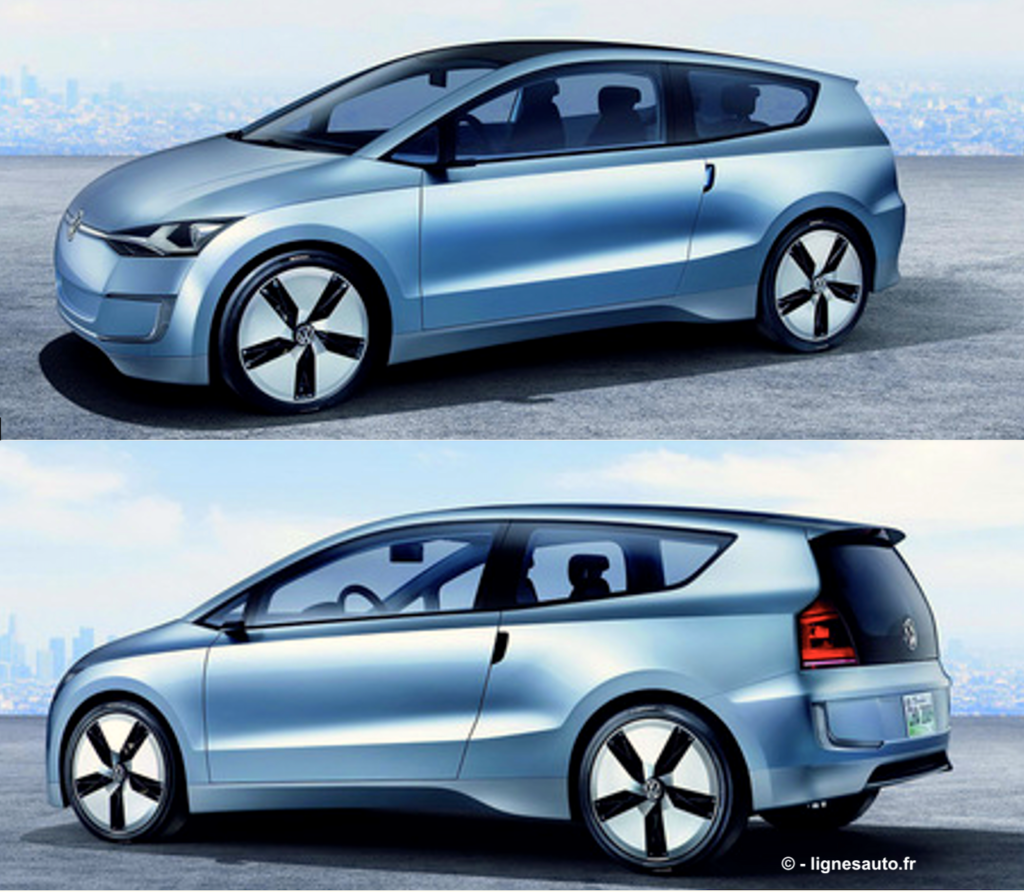
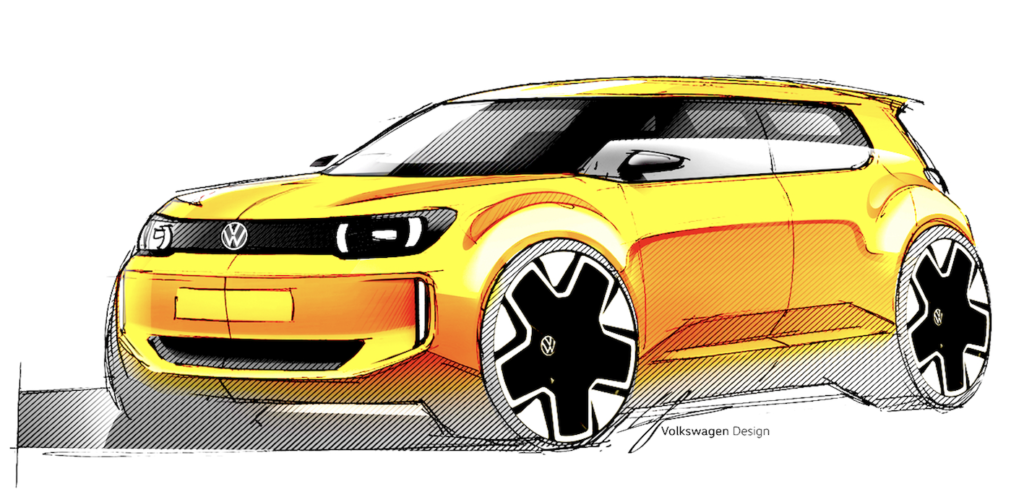
Between Renault and Volkswagen, the news is hard to follow. Renault wanted to produce its 2026 Twingo by sharing its platform with Volkswagen, but the latter rejected the French offer. And when Renault launched its 5 E-Tech, Volkswagen presented its larger ID2, and even its 226 hp GTI version below to tease the Alpine A290.
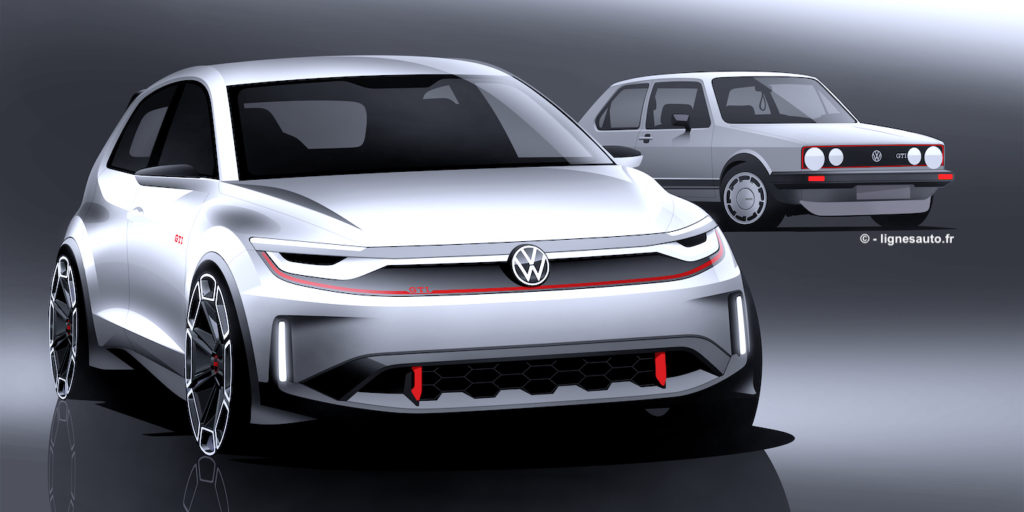
Finally, while Renault has once again outdone the competition in terms of communication by unveiling the prototype of its 2026 Twingo (below in green), Volkswagen is now responding with its ID Every 1, future ID1 (below in yellow) which will arrive a year after the Twingo. In short, the two manufacturers, friends or enemies, are both developing the same product plans, but not with the same design.

However, it must be admitted that Volkswagen missed the boat! The manufacturer had a rival to the electric Twingo in the pipeline long before Renault received the boost from Luca de Meo’s teams in 2020. The German burned his bridges 18 years ago with products that would have been perfectly suited to the current era. Being right too soon? It happens to all manufacturers, especially with their concept cars…
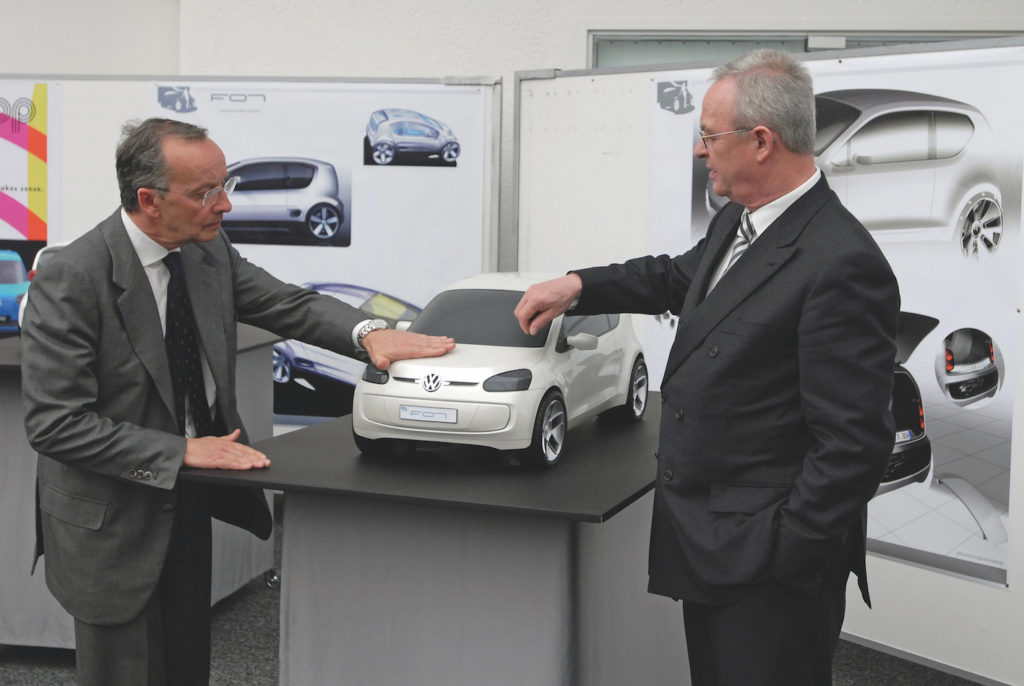
The Volkswagen version of Renault’s “Twingo” existed in the 2010s with the Up! A German copy of the French concept, you might say? Yes, except that Volkswagen’s ambition was great at the time: to form a family of several models based on the VW Up! (below). A bit like Renault, which has a family of iconic vehicles on the same platform: R4, R5, Twingo and soon Micra or even Dacia Spring. So, in September 2007, the Volkswagen Up! concept arrived with a bold design: its engine is at the back! The concept is compact and fits into the B1 segment where the Toyota Aygo, Peugeot 107 and Citroën C1 arrived in 2005. A rear engine? Well, that’s exactly the technical option that the Renault and Mercedes (Smart) duo will choose for the… Twingo and Smart Forfour in 2014.
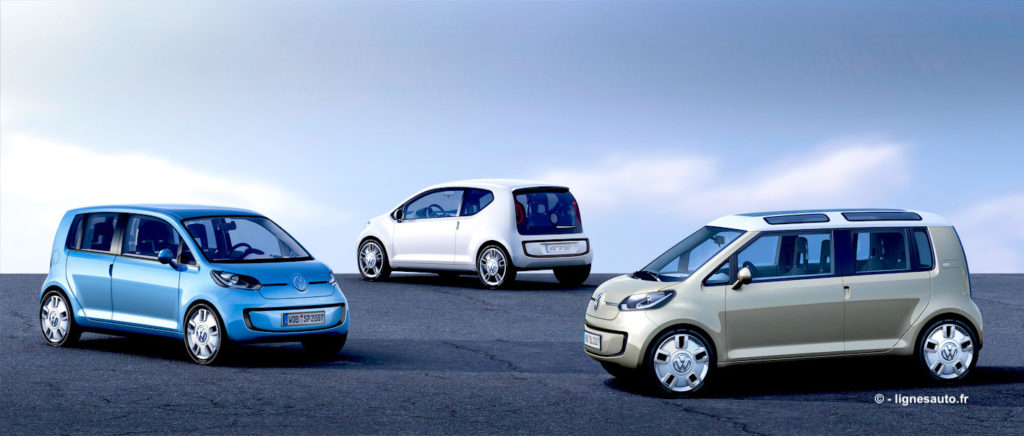
The Up! concept, only 3.45 m long (below), unveiled in Frankfurt in 2007 – 18 years ago now – was officially “the first vehicle of the NSF: New Family Vehicle.” A presumptuous family because, indeed, the German brand is launching a real fireworks display. Judge for yourself: September 2007, target 3 liters/100 with the Up! The unofficial target is to produce 4.5 million NSFs over a lifespan of 9 years. The Up! will be the first to hit the market in 2011.
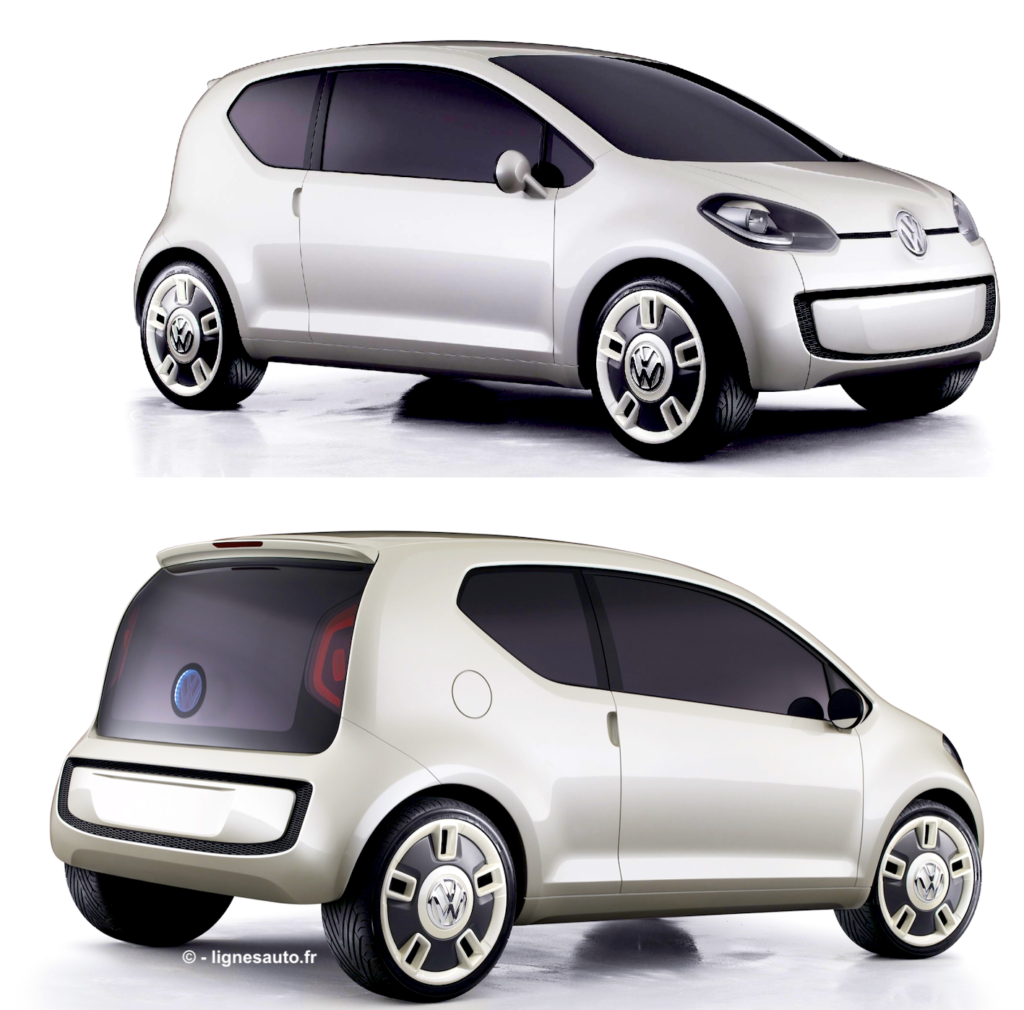
One month later, in October 2007, the Space Up! concept was unveiled at the Tokyo Motor Show (below). It is a volumetric vehicle based on the Up! with a length of 3.68 meters, 23 centimeters longer than the latter. It is the long-awaited “micro-van” and it too is based on a rear-engine architecture. Like the original Beetle or Combi! And that’s not all: the family will welcome even more variants with innovative advances in terms of powertrains.
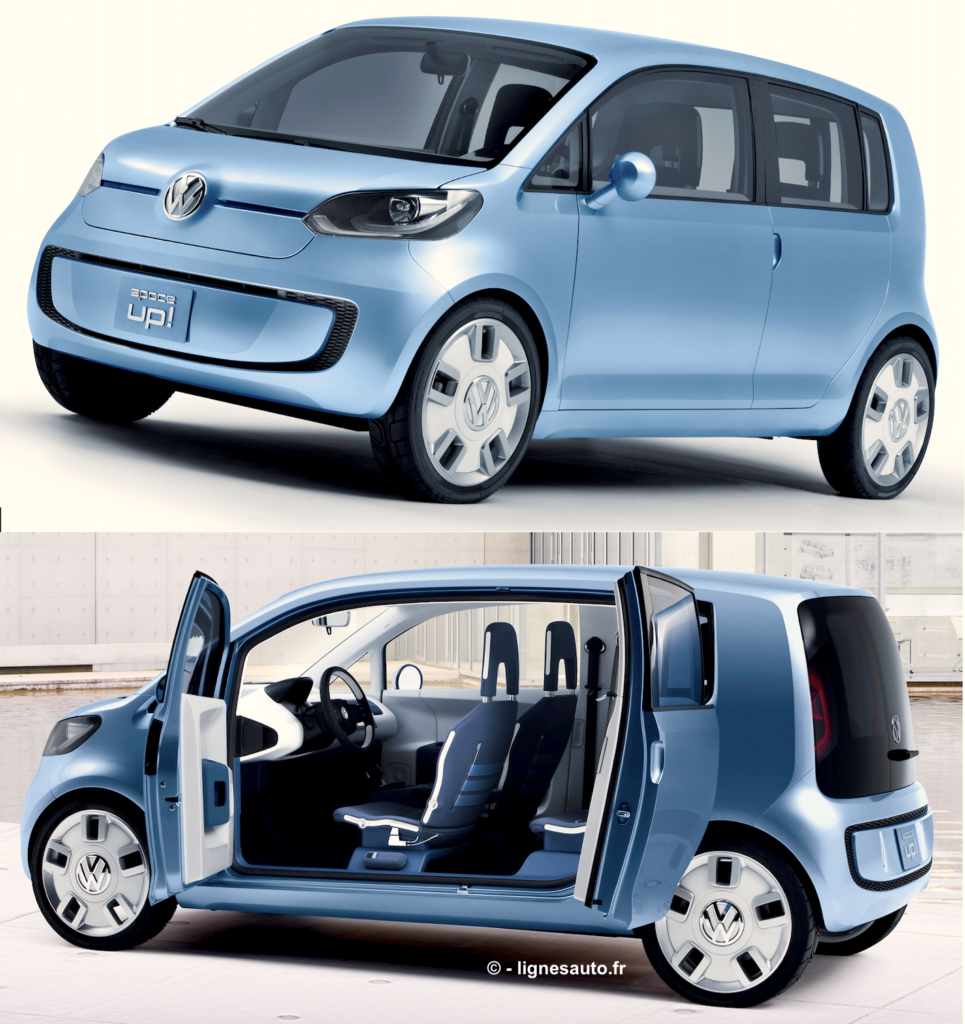
In December 2007, it was the turn of the Space Up! blue-e-motion to be presented at the Los Angeles show. This third member of the NFV family below features a fuel cell-powered technical architecture. Its electric motor develops 61 hp, still on the rear axle, while the fuel cell is at the front. This variant retains the 3.68 m length of the Space Up! thermal and weighs just over a ton.

Behind the scenes, Volkswagen has secretly and profoundly modified the technical architecture of the production project of the Up! (it will go into production in 2011), which sees its drive train abandoning the historic (!) rear-wheel drive for a classic front-engine and front-wheel drive architecture. And in 2009, just as Renault was launching its concept cars at the Frankfurt Motor Show, announcing its ambition to develop an electric range with the beginnings of the electric Zoe, Fluence, Kangoo be-bop and Twizy, the German manufacturer made an exclusive announcement by unveiling a 100% electric “mini-Up!”
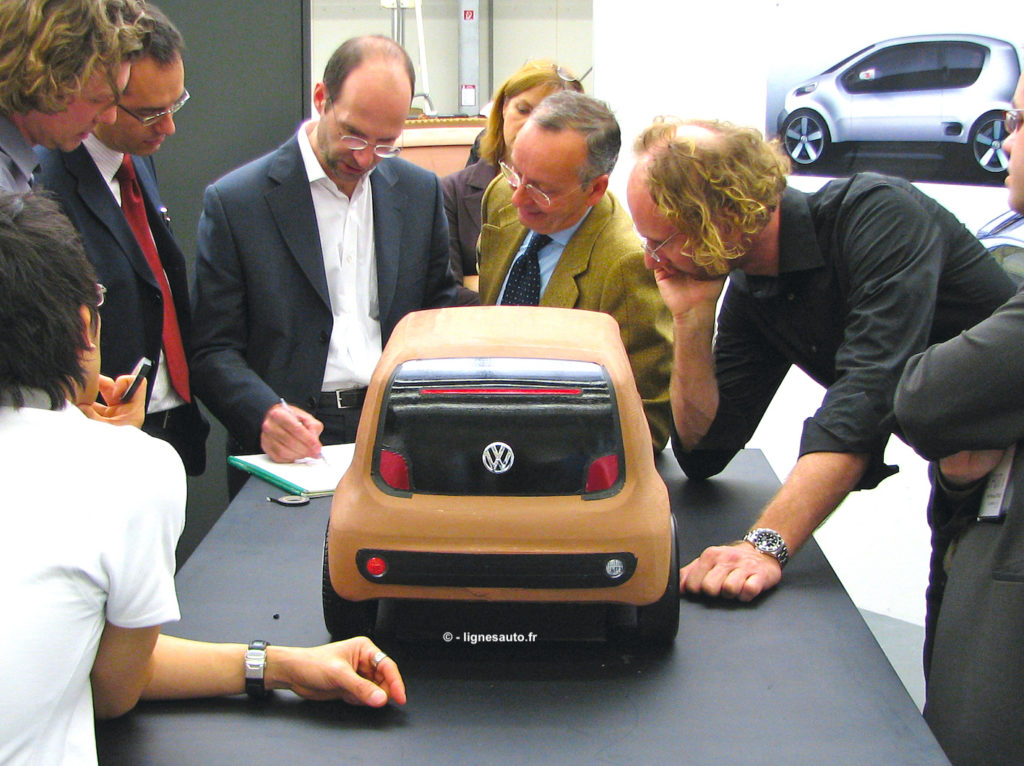
In September 2009, Volkswagen boss Martin Winterkorn announced that the shortened version of the Up! (below) would be produced from 2013 with a 100% electric drive train: the Up! blue-e-motion. Its 60 kW electric motor is located at the front, making it a front-wheel drive. Its battery is small (18 kWh) and light (240 kg). The 130 km range may raise a smile today, but the Up! blue-e-motion falls into the “B0” category, i.e. very compact cars: 3.19 m for the then electric Up! concept, barely longer than a Toyota iQ. Solar cells are installed on the roof and on the back of the… sun visors! The VW chip was almost 20 years ahead of its time. Easy to say today, of course.
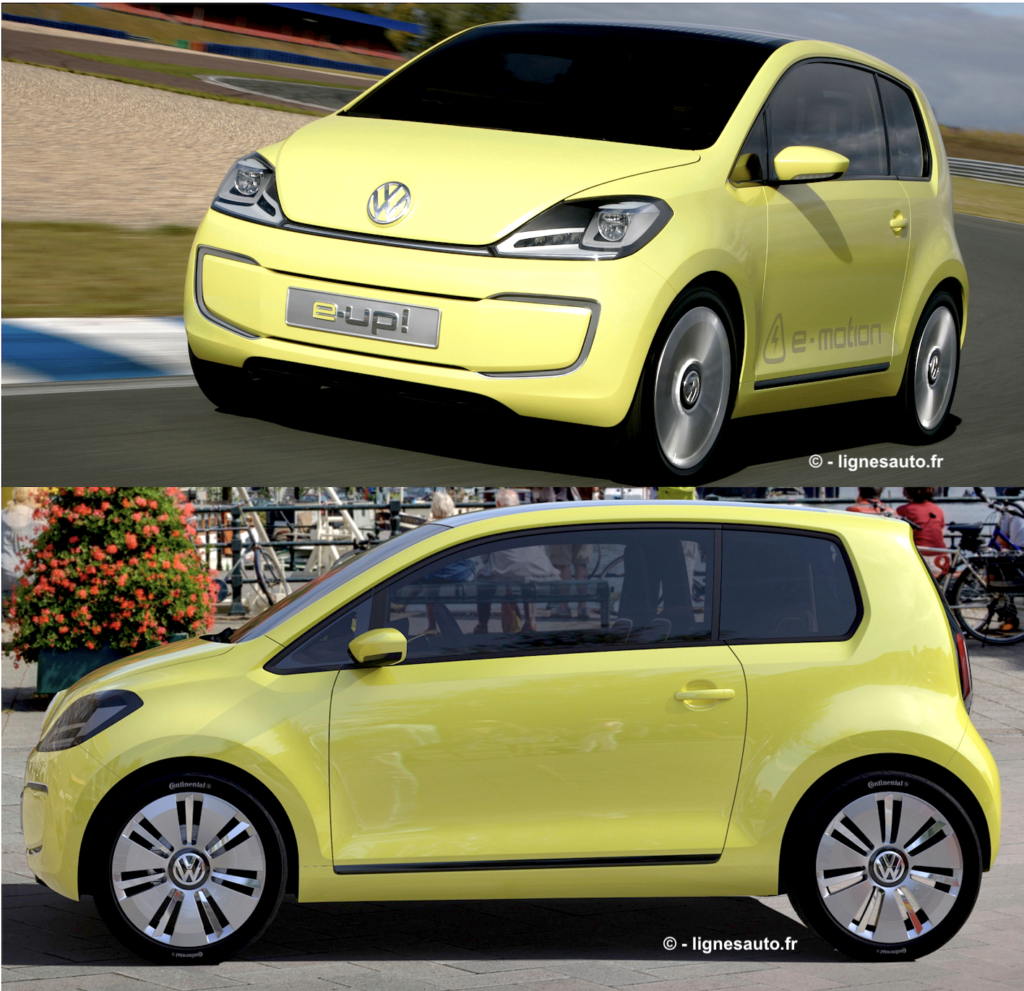
This Up! blue-e-motion concept is a small city car with 3 + 1 seats that offers the possibility of taking several means of micromobility on board (scooter, electric scooter, etc.). Inside (below) there is a touch screen, while the passenger seat is 50 mm further forward than the driver’s seat, to allow more comfort for the rear passenger. As on the Toyota iQ again… The boot capacity is announced as between 85 and 520 liters and it is possible to load an object 2 m long by tilting the front passenger seat. At the back of the boot, there is a compartment for stowing the ‘PedTric’ (electric scooter). The standard e-Up! version was based on the much larger internal combustion version…
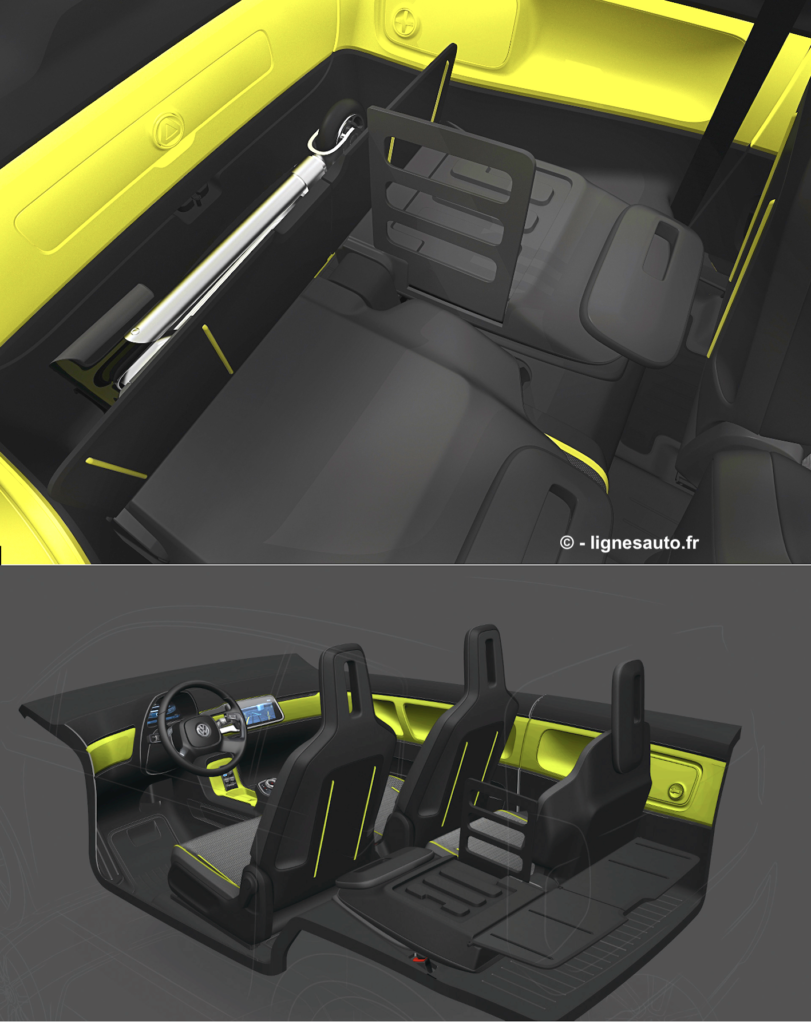
Since then, Volkswagen has obviously changed its boss and its projects and left the famous Dieselgate behind it. The road to all-electric has been fraught with obstacles and the current management – particularly in terms of design – seems to have put the brand back on the right track with a little more pragmatism and a welcome return to its roots. The delay in recent years, particularly compared to Renault (below, the Twingo in green), has not, however, altered the ambitions of the manufacturer, which announced its “Volkswagen Future” plan and its new vision last December…
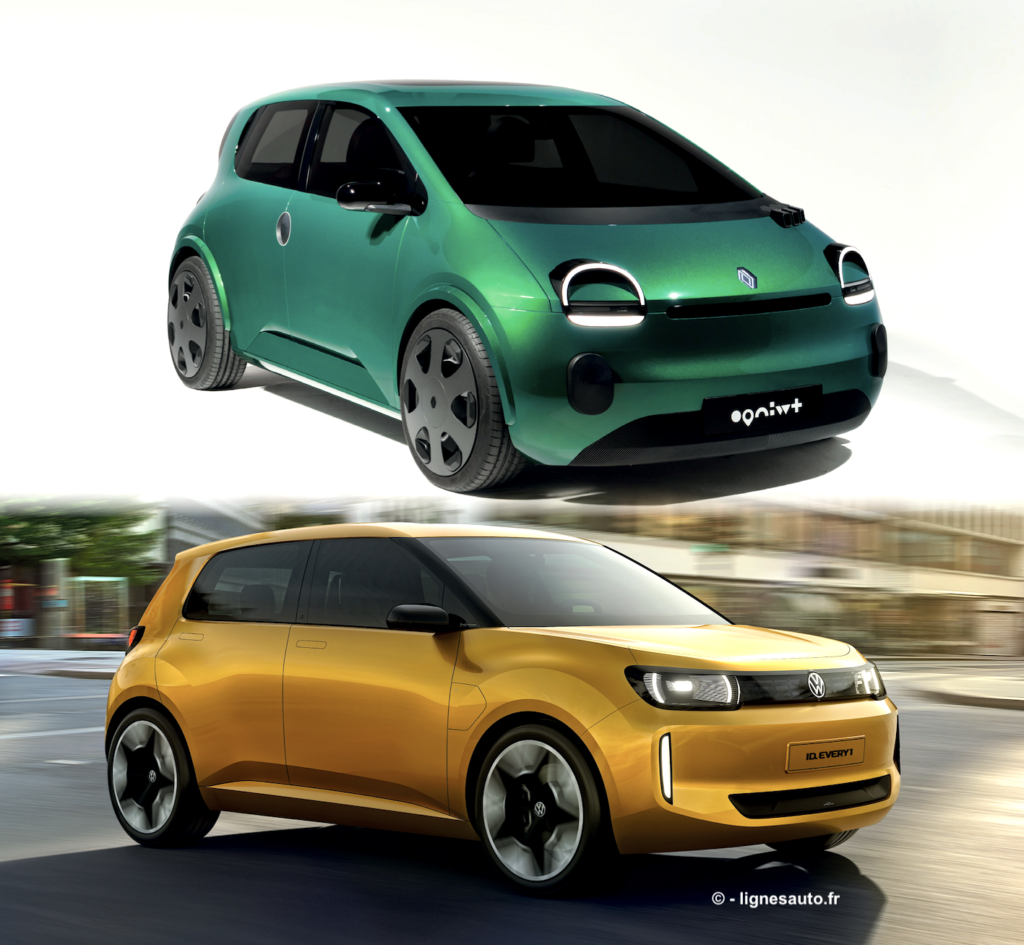
He explained that “the brand will follow a three-phase plan: strengthening competitiveness by targeted expansion of the existing model range; the Volkswagen brand will then give a preview of the new Electric Urban Car Family in the fall of 2025. By 2027, nine new models will be launched on the market, including the ID.2all for less than 25,000 euros and the ID. Every1 (above in yellow) for around 20,000 euros.”

At the end of the year, as mentioned above, Volkswagen will reveal the details of its family of urban electric cars, including the ID2, ID1 and also the small SUV based on the ID2. Here again, Volkswagen had taken a certain lead over Renault with the ID Life concept car of 2021. But the Renault 4 E-Tech (above compared to this Life concept) is on sale, while the next ID2 SUV is being tested. Is it really necessary to be right too soon?
Question: what if Volkswagen is mainly harming Dacia?
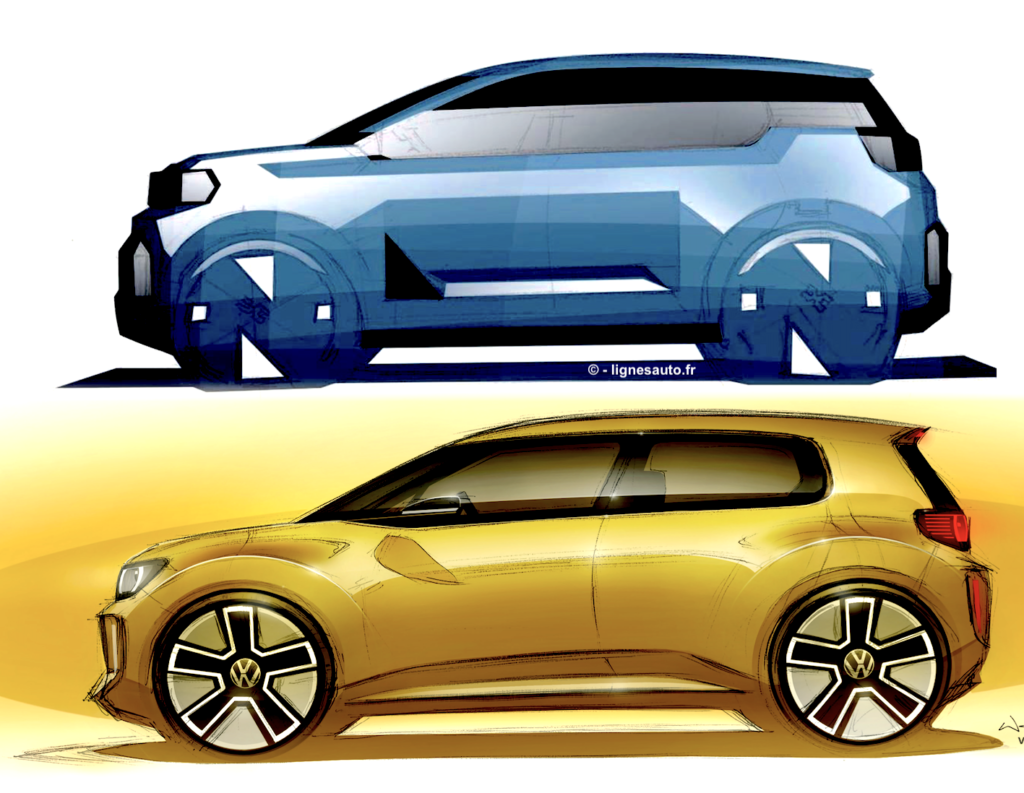
Many of us are already comparing the future Volkswagen ID1 with the Renault Twingo: two 100% electric city cars costing less than €20,000, which will be released in 2026 for the French car and in 2027 for the German one. However, the first illustration of the future Spring (above in blue) unveiled by Dacia, with its very SUV character, suggests that the little Volkswagen (above in yellow) could harm the Romanian rather than the French company. To be continued…

BONUS LIGNES/car: other small Volkswagens

Volkswagen has explored several avenues in the past to enter the world of the city car. The Chico/1 in 1975, the Student in 1982 (above) and the Chico/2 in 1992 (below). But the origin of the modern “small” Volkswagen goes back to the Polo, which was born in 1975: it is therefore celebrating its 50th anniversary this year! In the “small” VW family, the Lupo followed from 1998 to 2005, with the famous 3-liter Lupo version. In 2005, Volkswagen launched the 3.82-meter Fox in Europe.
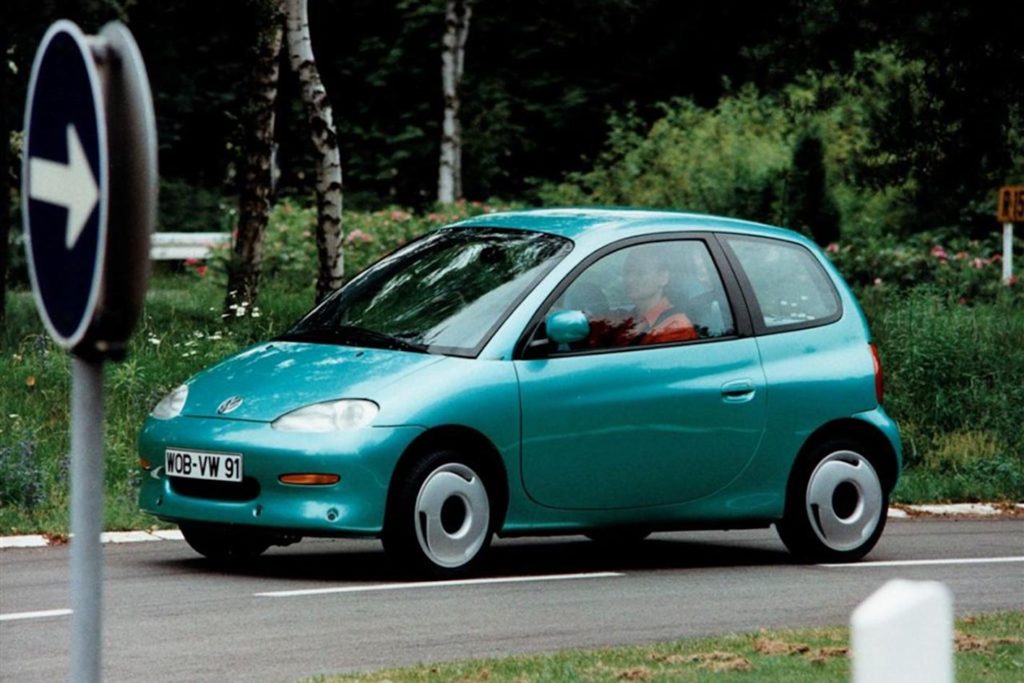
BONUS LIGNES/auto: Volkswagen Up! Lite (2009)
From 2007 and the Up! concept car with rear engine to 2011 and the marketing of the production model of the same Up! with front engine, Volkswagen launched a plethora of concept cars heralding the family (the NSF: New Family Vehicle) that would not last. Among these concepts, let us mention the Volkswagen Up! Lite below. With a length of 3.84 m, it offered a very aerodynamic volume (Cx: 0.237) and represented the ultimate child of the NSF family. Its powertrain offered a diesel hybridization with a 800 cm3, 51 hp TDI two-cylinder engine at the front and a 10 kW electric motor at the rear. The Lite had 4 seats and weighed only 695 kg. Its consumption was 2.44 l/100 km. The “1-liter car” (2002), L1 (2009) and XL1 (2011) prototypes are from the same family as the Lite concept.
